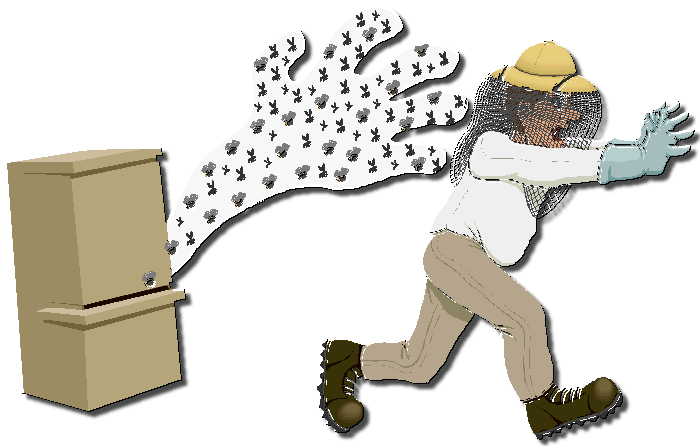 |
ENTOMOLOGY 2040
SECTION VIII
KILLER BEES - BRAZILIAN HONEY BEES |
LEARNING OBJECTIVES OF SECTION
After completing this section students should be able to:
- Describe the origin of the Brazilian honey bees.
- Explain why it is so difficult to distinguish between Brazilian bees and our honey bees.
- Describe the present distribution and potential range of Brazilian bees.
- Describe the differences in basic behavior between our honey bees and the Brazilian bees.
- Explain what a person should do in the event of an attack by these aggressive Brazilian bees.
- Explain why experts believe that Brazilian bees will be limited to the southern states.
- Describe how the Brazilian bees have been used in "horror" movies.
Terms: Killer bee, Brazilian bees, domestic honey bee, Multivariate analysis, Isozyme,
Winter cluster, swarming, absconding, venom chemistry, honey production, smoker.
- Killer Bees - Brazilian Honey Bees
- 1. Origin. Brazilian or African honey bees. African bees brought to Brazil.
- 2. Current distribution and movement.
- 3. Characteristics of the bees.
- a. Color.
- • Highly variable--yellow to black in same colony.
- • Size. Generally smaller than European bees.
- 4. Identification.
- a. Combination of characters needed.
- • Daly's multilvariate analysis.
- • Izozyme studies.
- 5. Individual development.
- a. Takes one day less than European bees, for workers, not reproductives.
- 6. Colony development.
- a. Growth rapid, result of higher numbers of eggs produced?
- 7. Behavior.
- a. No winter cluster formed--tropical bees.
- b. General activity.
- • More excitable and active than European bees.
- • More "nervous" in all activities.
- 8. Production. Generally thought Brazilian bees more productive.
- 9. Absconding. Entire colony leaves hive. More frequent for Brazilian
bees than European bees.
- 10. Swarming. More often? or just more reproductive.
- 11. Stinging.
- a. Best known characteristic.
- • Aggressive.
- • "Attack" and kill animals.
- • No difference in sting severity.
- • No difference in venom chemistry.
- • Much more easily disturbed.
- • Ability to communicate alarms within colonies and between colonies.
- • Capacity to respond with massive, persistent attacks.
a) TIME to first sting from colony and number of stings in 60 seconds.
- Brazilians = 14 secs -- 34.9 stings.
- Caucasians = 229 secs -- 1.4 stings.
b) Pursue intruder further.
- Brazilians = 160.2 m.
- Italians = 21.5 m.
c) Longer to quiet down.
- Brazilians = 28.2 minutes.
- Italians = 2.9 minutes.
- 12. Impact on beekeeping in Brazil.
- a. More production, fewer colonies.
- b. Beekeepers like the bees.
- c. Beekeepers move out of town, colonies in smaller apiaries.
- d. More space between colonies.
- e. Use of large smokers.
- f. Use of protective clothing.
- g. Few hobby beekeepers.
- h. More productive bees.
STUDY QUESTIONS
- Where did "Killer bees" evolve? Why are they so aggressive?
- How do you distinguish between a killer bee and a regular honey bee?
- What will eventually limit the movement of the Killer bee to the northern U.S.?
- How does venom of the killer bee differ from that of the domestic honey bee?
- How many stings from a killer bee does it take to equal the venom delivered in a rattlesnake bite?
- Are killer bee attacks to humans generally fatal? What age groups are most often killed?
- How do killer bee colonies reproduce? What is "absconding"? How does it differ from "Swarming"?
- When a killer bee colony swarms it is much less aggressive than at other times. Why is this the case?
- How have beekeepers in Mexico dealt with the invasion of the killer bees?
- How were the killer bees controlled in the movie "The Savage Bee"?
Go to Section IX - Insects as Food and Fiber Producers
<< back

